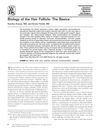Putting the Human Hair Follicle Cycle on the Map
January 2016
in “Journal of Investigative Dermatology”

TLDR The research created a model to understand human hair growth cycle, which can help diagnose and treat hair growth disorders and test potential hair growth drugs.
The 2015 document "Putting the Human Hair Follicle Cycle on the Map" developed a xenograft model to study the human hair follicle cycle by grafting human skin onto immunocompromised mice. This model was used to study over a thousand human anagen hair follicles, observing follicular morphology at 45 time points between days 2 and 402 after grafting. The study found this model useful for studying hair cycle biology and pathology, and for testing potential hair cycle-modulating drugs. The research also provided a guide for identifying the stages of the hair follicle cycle, crucial for diagnosing and treating hair growth disorders.
View this study on jidonline.org →
Cited in this study

research A Guide to Studying Human Hair Follicle Cycling In Vivo
The document provides a method to classify human hair growth stages using a model with human scalp on mice, aiming to standardize hair research.

research Neuroendocrinology of the hair follicle: principles and clinical perspectives
Hair follicles are hormone-sensitive and involved in growth and other functions, with potential for new treatments, but more research is needed.

research Role of hair papilla cells on induction and regeneration processes of hair follicles
Hair papilla cells can create and regenerate hair bulbs under the right conditions.

research Human Hair Follicle Regeneration Following Amputation and Grafting into the Nude Mouse
Human hair follicles can regenerate after removal, but with low success rate.
Related

research Morphogenesis, Growth Cycle, and Molecular Regulation of Hair Follicles
Hair growth and health are influenced by factors like age, environment, and nutrition, and are controlled by various molecular pathways. Red light can promote hair growth, and understanding these processes can help treat hair-related diseases.

research Putting the Human Hair Follicle Cycle on the Map
The research created a model to understand human hair growth cycle, which can help diagnose and treat hair growth disorders and test potential hair growth drugs.

research Biology of the Hair Follicle: The Basics
The document concludes that understanding hair follicle biology can lead to better hair loss treatments.